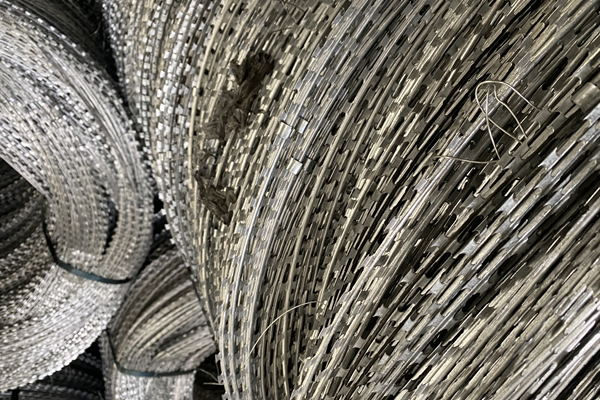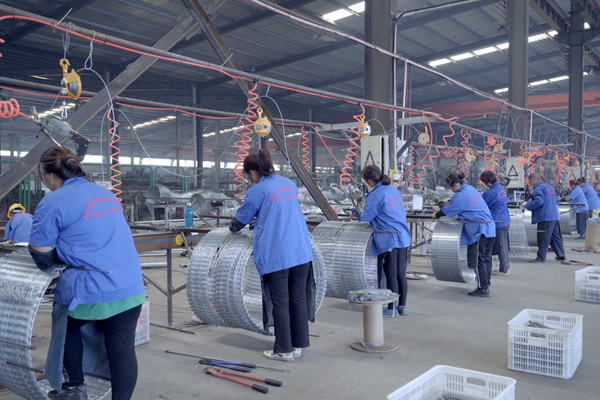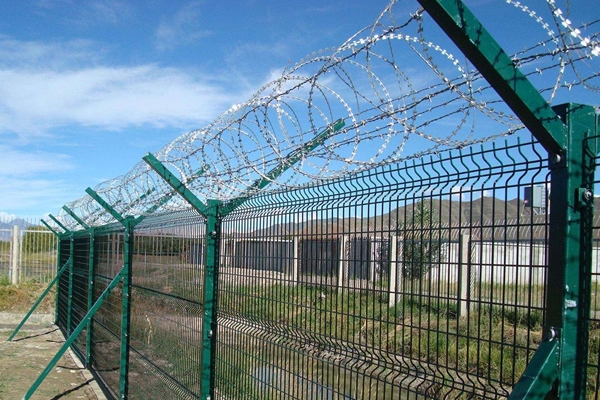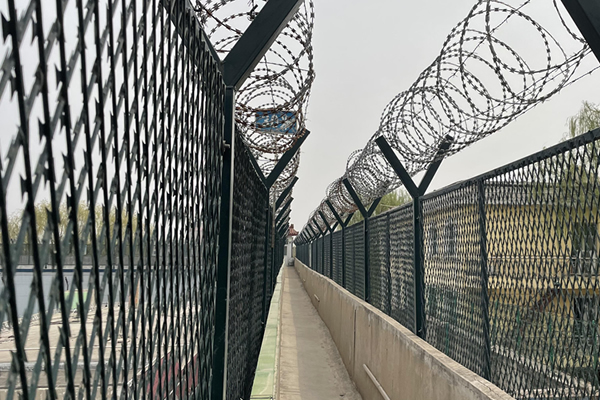Hebei ZhenXing JinYuan Wire Mesh Group specializes in manufacturing and exporting Razor Wire Fence products, designed for stringent security needs in high-risk environments. Our products merge the strength of physical barriers, like chain-link fences, with razor wire’s deterrent capabilities, ensuring robust security and restricted access to protected areas. The fences feature a durable frame that maintains the razor wire’s tension and effectiveness. While adaptable to various fencing types, chain-link is preferred for its durability and versatility. Tailored to meet specific site requirements, our Razor Wire Fence products come in different sizes, blade styles, and configurations. Built to endure harsh conditions, they guarantee longevity and consistent performance.
The structure includes several key components: razor wire, steel posts and frames, choice between chain link fence or anti-climbing 358 mesh fence, gates, and additional accessories.
A.Razor Wire
Raw Materials
Razor wire, a widely used security fencing material, is manufactured from several key raw materials:
- Steel Core Wire: The core wire is typically made of high-tensile steel. This material is chosen for its strength and flexibility, essential for supporting the razor-sharp barbs and ensuring the wire retains its shape under stress.
- Metal Barbs or Blades: The razor-sharp elements of the wire are usually made from galvanized steel or stainless steel. These metals are resistant to corrosion, which is crucial for outdoor applications where the wire is exposed to various weather conditions.
- Galvanization Coating: To enhance durability and resistance to rust and corrosion, the steel core and blades are often galvanized. Galvanization involves coating the steel with a protective layer of zinc. This process extends the lifespan of the razor wire, especially in outdoor and harsh environmental conditions.
- Stainless Steel (Optional): In some high-end or specialized applications, stainless steel may be used for both the core wire and blades. Stainless steel offers enhanced resistance to corrosion and weathering, making it ideal for use in coastal or harsh industrial environments.
Blade Type
The different blade types for Barbed Tape Obstacles (BTO) and Concertina Barbed Tape (CBT) each have their specific features and general dimensions. These types are designed for various security needs and settings. Here’s a detailed look at each:
- Blade Thickness: Usually ranges from 0.5 mm to 0.6 mm.
- Material: Typically made of galvanized steel or stainless steel.
- Spacing: Blade spacing can vary but is often around 25 mm to 100 mm apart.
- Coil Diameter: Varies based on type, generally between 450 mm to 980 mm for concertina types.
- BTO-10(Barbed Tape Obstacle)
Blade Length: 10 mm
Designed for low-security applications
Shorter blade length offers a basic deterrent - BTO-18(Barbed Tape Obstacle)
Blade Length: 18 mm
Suitable for moderate security requirements
Longer blades provide increased deterrence compared to BTO-10 - BTO-22(Barbed Tape Obstacle)
Blade Length: 22 mm
Commonly used for general security applications
Offers a balance between deterrence and cost-effectiveness - BTO-28(Barbed Tape Obstacle)
Blade Length: 28 mm
For higher security areas
Larger blades for greater injury risk and deterrence - BTO-30(Barbed Tape Obstacle)
Blade Length: 30 mm
Ideal for high-security installations
Longest blades in the BTO series for maximum security - CBT-60 (Concertina Barbed Tape)
Blade Length: 60 mm
Used in high-security settings
Large, aggressive blade design for significant deterrent effect - CBT-65(Concertina Barbed Tape)
Blade Length: 65 mm
Typically employed in military and high-level security areas
Very large blades for maximum deterrence and injury potential - Nots: Can be installed atop walls or fences, or laid on the ground in a concertina coil format. Each blade type is designed for specific security needs, with the choice depending on the level of deterrence required. The larger and more aggressive the blade, the higher the level of security and injury risk it presents, making it suitable for more sensitive or high-risk areas.
B. Steel Posts and Frame
The structure of a frame steel fence, especially when designed to support razor wire, consists of several key elements, each with specific dimensions for optimal functionality and security. The common dimensions, expressed in millimeters (mm), are as follows:
- Material: Typically made from galvanized or stainless steel, known for rust and corrosion resistance. While steel is common, other metals can be used. Steel frames typically have a thickness of 2 mm to 4 mm.
- Supporting Posts and Brackets: These are used to install and support the razor wire at the top of the fence and gates. They must be strong and durable to hold the weight and tension of the razor wire.
- Vertical Steel Posts: The main support structures. Their thickness can range from 2 mm to 4 mm, and their height varies based on application, often between 2000 mm to 3000 mm.
- Horizontal Framing: Connects the vertical posts, with a typical thickness of 2 mm to 4 mm and length depending on the fence width.
- Y Fence Post: The Y post top has a ‘Y’ shape, specifically designed for razor wire fences. Increases security by making it difficult to gain a grip or foothold. The Y-shaped top supports razor wire. The ‘Y’ portion usually extends 100 mm to 200 mm above the main post, with arms extending outwards by approximately 150 mm to 250 mm.
- Corner Posts: Stronger and often larger than regular posts, corner posts provide additional support at the corners of the fencing, where tension is highest.
- Nots: The frame’s function is to keep the razor wire effectively stretched and in place. The thickness and strength of the frame are adjustable; higher security areas require steel of greater thickness and strength. While common dimensions exist, they can be customized to meet specific security needs and environmental conditions.
C. Steel Fence Panels
Generally, razor wire fence is often used in conjunction with a chain link fence or an anti-climbing 358 mesh fence. This combination enhances security by pairing the deterrent effect of razor wire with the robust physical barriers provided by chain link or 358 mesh fencing.
- Chain link fences are a popular choice for both residential and industrial areas due to their durability and cost-effectiveness. The two common types are: Standard Galvanized Chain Link Known for its durability, this type is widely used for boundary and security fencing. Its galvanization process makes it resistant to rust, making it a practical choice for various settings. PVC-Coated Chain Link type adds extra durability and aesthetic appeal to the standard chain link fence. The PVC coating not only enhances its resistance to weathering but also allows for a variety of color options. It’s commonly used in residential areas and public spaces for both security and visual appeal.
- Anti-Climbing 358 Mesh, also known as “358 mesh fencing” or “prison mesh,” is a high-security fencing designed to prevent unauthorized access, ideal for prisons, military bases, airports, and industrial sites. Its name derives from its mesh pattern, with a 3″ (76.2mm) x 0.5″ (12.7mm) aperture and 8 gauge (4mm) wire diameter, ensuring a robust and durable structure. The small mesh openings effectively deter climbing, crucial for high-security facilities. While primarily used in prisons and military installations, its use has expanded to transportation hubs, power plants, and commercial areas requiring enhanced security.
D. Fence Gates
Razor wire fence gates, crucial in high-security fencing systems, are typically made from the same durable metal as the fence, often reinforced with additional razor wire layers for enhanced security. Available in various designs like swing and sliding models, they suit different entry types and operational needs. A key feature is the integration of razor wire at the top or other parts of the gate.
- Material and Design: Made from strong metal, gates are often reinforced with razor wire. Swing gates and sliding gates vary in size, typically ranging from 1000 mm to 4000 mm in width for pedestrian and vehicle access.
- Integration with Razor Wire: Razor wire is installed at the top, often extending 500 mm to 1000 mm above the gate.
- Locking Mechanisms: Various high-security locks are used, with electronic controls often having dimensions around 150 mm x 100 mm.
- Size and Customization: Gate sizes can be customized, with pedestrian gates generally around 1000 mm to 1200 mm in width, and vehicle gates ranging from 3000 mm to 4000 mm in width.
E. Mounting Accessories
Razor wire fence additional accessories are essential in creating a secure, functional, and comprehensive perimeter security system. Their design and installation require careful consideration to maintain the integrity and effectiveness of the razor wire fence.
- Tension Wires: These wires help keep the razor wire taut and effective. They are particularly important in long stretches of fencing.
- Warning Signs: To comply with safety regulations and to warn people about the hazardous nature of the razor wire, warning signs are often installed along the fence.
- Coil Connectors: These are used to connect sections of razor wire coils, ensuring continuous and secure coverage.
- Anchor Plates: Anchor plates are used to secure fence posts in the ground, providing stability to the fence structure.
- Gate Sensors and Alarms: For enhanced security, sensors and alarms can be integrated into the gate system to alert security personnel of any unauthorized access attempts.
Advantages and Applications
- Enhanced Security: Sharp edges provide strong deterrence.
- Effective Trespassing Deterrent: Intimidating appearance prevents unauthorized access.
- Military Bases: For secure perimeter defense.
- Prisons: To prevent escapes.
- High-Security Areas: To protect sensitive locations.
See pictures for examples

Anti-Intrusion Razor Wire Fence is tailored for high-security areas like government buildings or private properties. Its intimidating design with razor wire acts as a formidable barrier against trespassers.

Concertina wire fence, featuring coiled razor wire resembling a concertina, is used primarily in military and high-security areas. Its circular, spiraling design enhances perimeter defense, making it a formidable barrier against intrusion.

Razor ribbon fence, known for its helical, ribbon-like razor wire, is commonly installed atop fences or walls in institutional and commercial settings. It blends security with a less intimidating look, making it suitable for visible boundary lines.

Perimeter Razor Wire Fence is designed for enclosing and protecting boundaries of sensitive areas like military bases and industrial sites. It acts as a strong deterrent against unauthorized entry, ensuring robust perimeter security.

